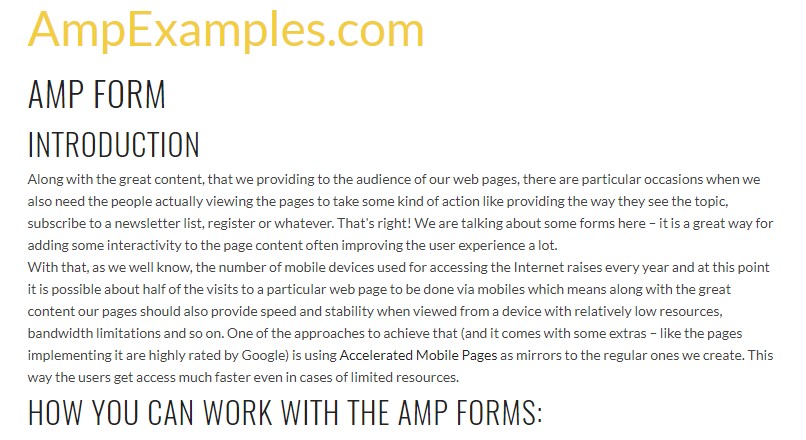Bootstrap Form Button
Intro
Bootstrap gives numerous form regulation styles, layout selections, along with custom-made components for producing a wide range of Bootstrap Form Input.
Forms provide the awesome system for getting some suggestions directly from the website visitors of our webpages. On the occasion that it is actually a simple touch or possibly registration form along with simply a couple of areas or else a complicated and well thought request the Bootstrap 4 framework got all the things that's required to perform the job and have awesome responsive appeal.
By default when it comes to the Bootstrap framework the form components are designated to span all size of its parent feature-- this gets achieved by selecting the .form-control class. The lebels and directions need to be wrapped inside a parent element using the .form-group class for the very best spacing.
Bootstrap Form Group regulations
Bootstrap's form commands extend upon our Rebooted form looks along with classes.
Use these kinds of classes to opt right into their customed displays to get a even more steady rendering all around web browsers and tools . The representation form below shows typical HTML form features that earn modified designs coming from Bootstrap together with more classes.
Keep in mind, due to the fact that Bootstrap uses the HTML5 doctype, all types of inputs must have a type attribute.
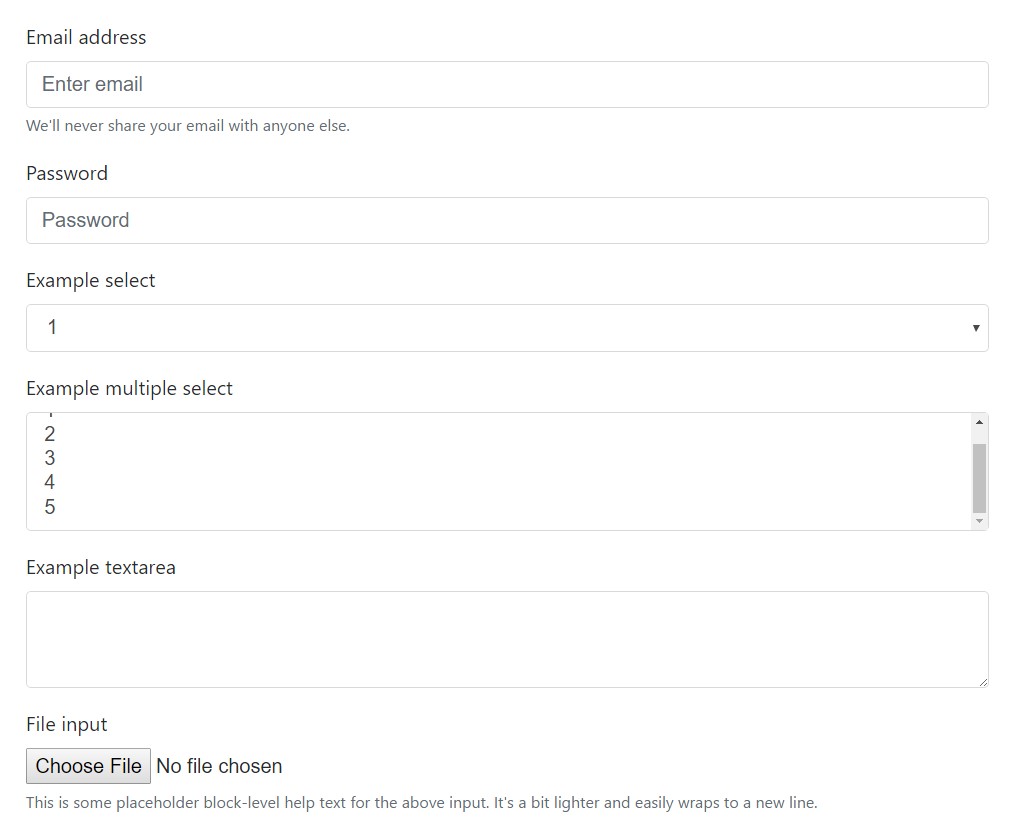

<form>
<div class="form-group">
<label for="exampleInputEmail1">Email address</label>
<input type="email" class="form-control" id="exampleInputEmail1" aria-describedby="emailHelp" placeholder="Enter email">
<small id="emailHelp" class="form-text text-muted">We'll never share your email with anyone else.</small>
</div>
<div class="form-group">
<label for="exampleInputPassword1">Password</label>
<input type="password" class="form-control" id="exampleInputPassword1" placeholder="Password">
</div>
<div class="form-group">
<label for="exampleSelect1">Example select</label>
<select class="form-control" id="exampleSelect1">
<option>1</option>
<option>2</option>
<option>3</option>
<option>4</option>
<option>5</option>
</select>
</div>
<div class="form-group">
<label for="exampleSelect2">Example multiple select</label>
<select multiple class="form-control" id="exampleSelect2">
<option>1</option>
<option>2</option>
<option>3</option>
<option>4</option>
<option>5</option>
</select>
</div>
<div class="form-group">
<label for="exampleTextarea">Example textarea</label>
<textarea class="form-control" id="exampleTextarea" rows="3"></textarea>
</div>
<div class="form-group">
<label for="exampleInputFile">File input</label>
<input type="file" class="form-control-file" id="exampleInputFile" aria-describedby="fileHelp">
<small id="fileHelp" class="form-text text-muted">This is some placeholder block-level help text for the above input. It's a bit lighter and easily wraps to a new line.</small>
</div>
<fieldset class="form-group">
<legend>Radio buttons</legend>
<div class="form-check">
<label class="form-check-label">
<input type="radio" class="form-check-input" name="optionsRadios" id="optionsRadios1" value="option1" checked>
Option one is this and that—be sure to include why it's great
</label>
</div>
<div class="form-check">
<label class="form-check-label">
<input type="radio" class="form-check-input" name="optionsRadios" id="optionsRadios2" value="option2">
Option two can be something else and selecting it will deselect option one
</label>
</div>
<div class="form-check disabled">
<label class="form-check-label">
<input type="radio" class="form-check-input" name="optionsRadios" id="optionsRadios3" value="option3" disabled>
Option three is disabled
</label>
</div>
</fieldset>
<div class="form-check">
<label class="form-check-label">
<input type="checkbox" class="form-check-input">
Check me out
</label>
</div>
<button type="submit" class="btn btn-primary">Submit</button>
</form>Listed below is a finished selection of the specific Bootstrap Form Example commands upheld by Bootstrap together with the classes which individualize them. Additional documents is readily available for each and every group.
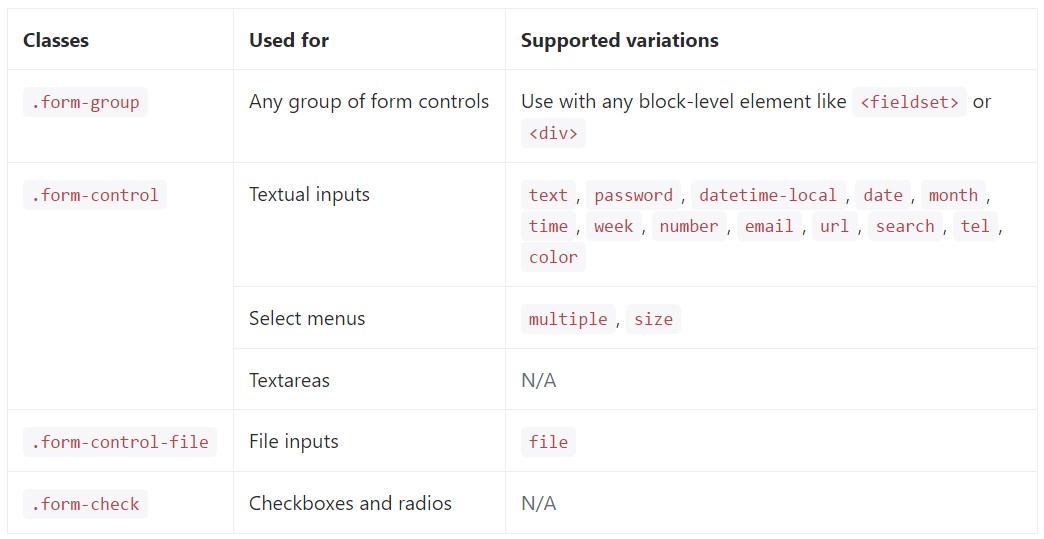
Textual inputs
Here are the illustrations of .form-control applied to each and every textual HTML5 <input> type.
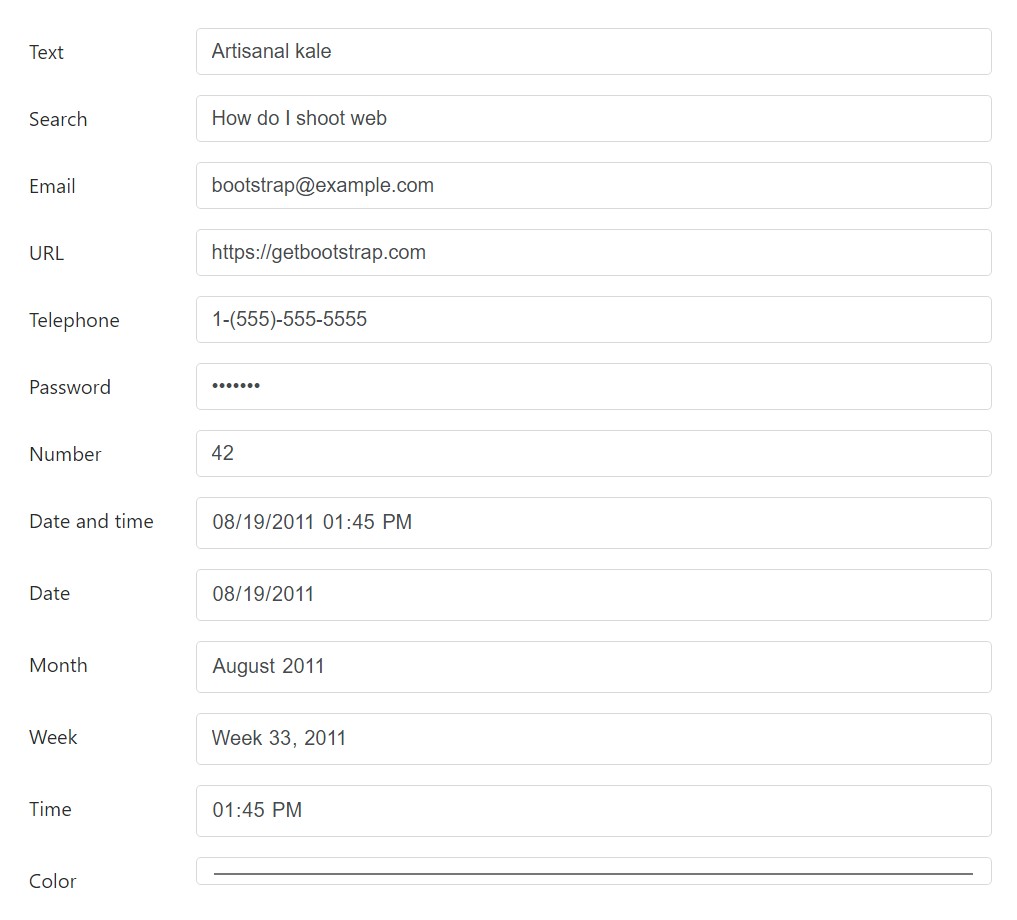
<div class="form-group row">
<label for="example-text-input" class="col-2 col-form-label">Text</label>
<div class="col-10">
<input class="form-control" type="text" value="Artisanal kale" id="example-text-input">
</div>
</div>
<div class="form-group row">
<label for="example-search-input" class="col-2 col-form-label">Search</label>
<div class="col-10">
<input class="form-control" type="search" value="How do I shoot web" id="example-search-input">
</div>
</div>
<div class="form-group row">
<label for="example-email-input" class="col-2 col-form-label">Email</label>
<div class="col-10">
<input class="form-control" type="email" value="[email protected]" id="example-email-input">
</div>
</div>
<div class="form-group row">
<label for="example-url-input" class="col-2 col-form-label">URL</label>
<div class="col-10">
<input class="form-control" type="url" value="https://getbootstrap.com" id="example-url-input">
</div>
</div>
<div class="form-group row">
<label for="example-tel-input" class="col-2 col-form-label">Telephone</label>
<div class="col-10">
<input class="form-control" type="tel" value="1-(555)-555-5555" id="example-tel-input">
</div>
</div>
<div class="form-group row">
<label for="example-password-input" class="col-2 col-form-label">Password</label>
<div class="col-10">
<input class="form-control" type="password" value="hunter2" id="example-password-input">
</div>
</div>
<div class="form-group row">
<label for="example-number-input" class="col-2 col-form-label">Number</label>
<div class="col-10">
<input class="form-control" type="number" value="42" id="example-number-input">
</div>
</div>
<div class="form-group row">
<label for="example-datetime-local-input" class="col-2 col-form-label">Date and time</label>
<div class="col-10">
<input class="form-control" type="datetime-local" value="2011-08-19T13:45:00" id="example-datetime-local-input">
</div>
</div>
<div class="form-group row">
<label for="example-date-input" class="col-2 col-form-label">Date</label>
<div class="col-10">
<input class="form-control" type="date" value="2011-08-19" id="example-date-input">
</div>
</div>
<div class="form-group row">
<label for="example-month-input" class="col-2 col-form-label">Month</label>
<div class="col-10">
<input class="form-control" type="month" value="2011-08" id="example-month-input">
</div>
</div>
<div class="form-group row">
<label for="example-week-input" class="col-2 col-form-label">Week</label>
<div class="col-10">
<input class="form-control" type="week" value="2011-W33" id="example-week-input">
</div>
</div>
<div class="form-group row">
<label for="example-time-input" class="col-2 col-form-label">Time</label>
<div class="col-10">
<input class="form-control" type="time" value="13:45:00" id="example-time-input">
</div>
</div>
<div class="form-group row">
<label for="example-color-input" class="col-2 col-form-label">Color</label>
<div class="col-10">
<input class="form-control" type="color" value="#563d7c" id="example-color-input">
</div>
</div>Form arrangements
Ever since Bootstrap uses display: block and width :100% to almost all our form controls, forms will most likely by default stack vertically. Supplemental classes can be chosen to vary this particular layout on a per-form basis.
Form sets
The .form-group class is the best solution to put in some design to forms. Its main target is to deliver margin-bottom about a label and regulate pairing. As a bonus, given that it is actually a class you can easily make use of it through <fieldset>-s, <div>-s, as well as just about some other component.

<form>
<div class="form-group">
<label for="formGroupExampleInput">Example label</label>
<input type="text" class="form-control" id="formGroupExampleInput" placeholder="Example input">
</div>
<div class="form-group">
<label for="formGroupExampleInput2">Another label</label>
<input type="text" class="form-control" id="formGroupExampleInput2" placeholder="Another input">
</div>
</form>Inline forms
Use the .form-inline class to present a set of labels, form regulations , and also buttons on a solitary horizontal row. Form controls inside of inline forms are different a bit from their default shapes.
- Controls are display: flex, dropping any HTML white-colored space and helping you to supply positioning management together with spacing plus flexbox utilities.
- Controls plus input groups receive width: auto to defeat the Bootstrap default width: 100%.
- Controls only show up inline within viewports which are at very least 576px large to account for thin viewports on mobile devices.
You may possibly ought to physically deal with the size and positioning of individual form controls plus spacing utilities ( just as indicated below) And finally, ensure to always involve a <label> together with every form control, even if you ought to cover it directly from non-screenreader site visitors with a code.

<form class="form-inline">
<label class="sr-only" for="inlineFormInput">Name</label>
<input type="text" class="form-control mb-2 mr-sm-2 mb-sm-0" id="inlineFormInput" placeholder="Jane Doe">
<label class="sr-only" for="inlineFormInputGroup">Username</label>
<div class="input-group mb-2 mr-sm-2 mb-sm-0">
<div class="input-group-addon">@</div>
<input type="text" class="form-control" id="inlineFormInputGroup" placeholder="Username">
</div>
<div class="form-check mb-2 mr-sm-2 mb-sm-0">
<label class="form-check-label">
<input class="form-check-input" type="checkbox"> Remember me
</label>
</div>
<button type="submit" class="btn btn-primary">Submit</button>
</form>Customized form controls and chooses are similarly maintained.

<form class="form-inline">
<label class="mr-sm-2" for="inlineFormCustomSelect">Preference</label>
<select class="custom-select mb-2 mr-sm-2 mb-sm-0" id="inlineFormCustomSelect">
<option selected>Choose...</option>
<option value="1">One</option>
<option value="2">Two</option>
<option value="3">Three</option>
</select>
<label class="custom-control custom-checkbox mb-2 mr-sm-2 mb-sm-0">
<input type="checkbox" class="custom-control-input">
<span class="custom-control-indicator"></span>
<span class="custom-control-description">Remember my preference</span>
</label>
<button type="submit" class="btn btn-primary">Submit</button>
</form>Alternatives to hidden labels
Assistive systems just like screen readers will certainly have problem utilizing your forms in the event that you don't feature a label for every single input. For these kinds of inline forms, you can cover the labels making use of the .sr-only class. There are actually even more different solutions of providing a label for assistive technologies, for example, the aria-label, aria-labelledby or title attribute. If not any of these occur, assistive techniques can resort to applying the placeholder attribute, in case that available, still, consider that application of placeholder considering that a replacing for other labelling methods is not really suggested.
Employing the Grid
For additionally organized form layouts which are equally responsive, you have the ability to use Bootstrap's predefined grid classes or else mixins to produce horizontal forms. Put in the .row class to form groups and make use of the .col-*-* classes to specify the width of your labels and controls.
Be sure to add .col-form-label to your <label>-s as well so they’re vertically centered with their associated form controls. For <legend> elements, you can use .col-form-legend to make them appear similar to regular <label> elements.
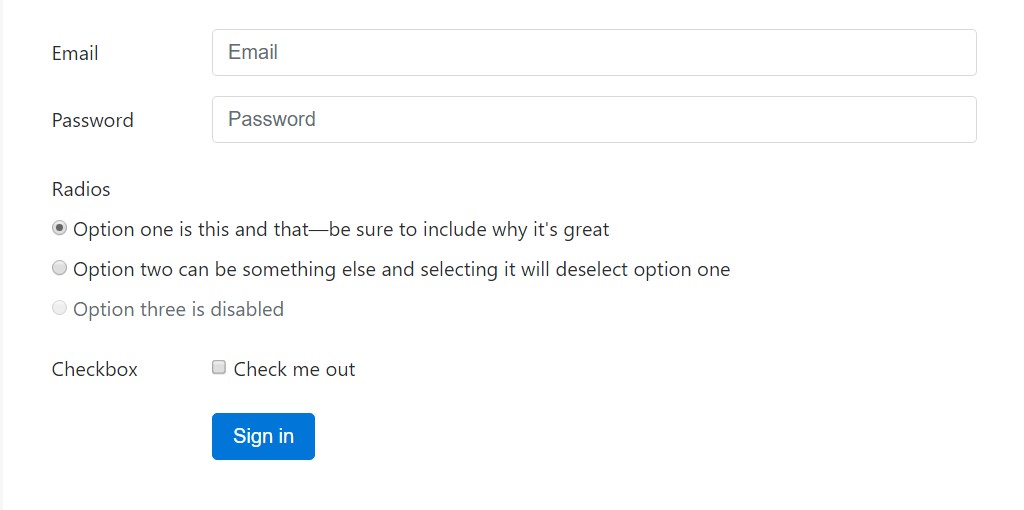
<div class="container">
<form>
<div class="form-group row">
<label for="inputEmail3" class="col-sm-2 col-form-label">Email</label>
<div class="col-sm-10">
<input type="email" class="form-control" id="inputEmail3" placeholder="Email">
</div>
</div>
<div class="form-group row">
<label for="inputPassword3" class="col-sm-2 col-form-label">Password</label>
<div class="col-sm-10">
<input type="password" class="form-control" id="inputPassword3" placeholder="Password">
</div>
</div>
<fieldset class="form-group row">
<legend class="col-form-legend col-sm-2">Radios</legend>
<div class="col-sm-10">
<div class="form-check">
<label class="form-check-label">
<input class="form-check-input" type="radio" name="gridRadios" id="gridRadios1" value="option1" checked>
Option one is this and that—be sure to include why it's great
</label>
</div>
<div class="form-check">
<label class="form-check-label">
<input class="form-check-input" type="radio" name="gridRadios" id="gridRadios2" value="option2">
Option two can be something else and selecting it will deselect option one
</label>
</div>
<div class="form-check disabled">
<label class="form-check-label">
<input class="form-check-input" type="radio" name="gridRadios" id="gridRadios3" value="option3" disabled>
Option three is disabled
</label>
</div>
</div>
</fieldset>
<div class="form-group row">
<label class="col-sm-2">Checkbox</label>
<div class="col-sm-10">
<div class="form-check">
<label class="form-check-label">
<input class="form-check-input" type="checkbox"> Check me out
</label>
</div>
</div>
</div>
<div class="form-group row">
<div class="offset-sm-2 col-sm-10">
<button type="submit" class="btn btn-primary">Sign in</button>
</div>
</div>
</form>
</div>Grid-based form arrangements also sustain large size and small-sized inputs.

<div class="container">
<form>
<div class="form-group row">
<label for="lgFormGroupInput" class="col-sm-2 col-form-label col-form-label-lg">Email</label>
<div class="col-sm-10">
<input type="email" class="form-control form-control-lg" id="lgFormGroupInput" placeholder="[email protected]">
</div>
</div>
<div class="form-group row">
<label for="smFormGroupInput" class="col-sm-2 col-form-label col-form-label-sm">Email</label>
<div class="col-sm-10">
<input type="email" class="form-control form-control-sm" id="smFormGroupInput" placeholder="[email protected]">
</div>
</div>
</form>
</div>Checkboxes and radios
Default radios and checkboxes are improved upon with the assistance of .form-check, a single class for both of these input types that increases the layout and actions of their HTML components. Checkboxes are for selecting one or else a number of choices within a list, as long as radios are for picking one solution from numerous.
Disabled checkboxes and radios are maintained, but to give a not-allowed pointer on hover of the parent <label>, you'll need to incorporate the .disabled class to the parent .form-check. The disabled class will additionally lighten the text message colour to help identify the input's state.
Each and every checkbox and radio is wrapped within a <label> for three causes:
- It supplies a bigger hit areas for checking the control.
- It brings a semantic and practical wrapper in order to help us replace the default <input>-s.
- It activates the state of the <input> automatically, indicating no JavaScript is involved.
We cover up the default <input> together with opacity and employ the .custom-control-indicator to construct a new customized form sign in its place. Unfortunately we cannot create a customized one from just the <input> simply because CSS's content does not function on that element..
We utilize the relative selector (~) for every our <input> states-- such as : checked-- to properly style our customized form indicator . While combined with the .custom-control-description class, we have the ability to also format the text message for each item built upon the <input>-s state.
In the checked states, we use base64 embedded SVG icons from Open Iconic. This provides us the best control for styling and positioning across browsers and devices.
Checkboxes

<label class="custom-control custom-checkbox">
<input type="checkbox" class="custom-control-input">
<span class="custom-control-indicator"></span>
<span class="custom-control-description">Check this custom checkbox</span>
</label>Custom checkboxes have the ability to in addition apply the : indeterminate pseudo class once manually set through JavaScript (there is really no accessible HTML attribute for specifying it).

In the case that you are actually employing jQuery, something like this should really be enough:
$('.your-checkbox').prop('indeterminate', true)Radios

<label class="custom-control custom-radio">
<input id="radio1" name="radio" type="radio" class="custom-control-input">
<span class="custom-control-indicator"></span>
<span class="custom-control-description">Toggle this custom radio</span>
</label>
<label class="custom-control custom-radio">
<input id="radio2" name="radio" type="radio" class="custom-control-input">
<span class="custom-control-indicator"></span>
<span class="custom-control-description">Or toggle this other custom radio</span>
</label>Default (stacked)
By default, any quantity of checkboxes and radios that are really close sibling will be vertically piled and also properly spaced by using .form-check.

<div class="form-check">
<label class="form-check-label">
<input class="form-check-input" type="checkbox" value="">
Option one is this and that—be sure to include why it's great
</label>
</div>
<div class="form-check disabled">
<label class="form-check-label">
<input class="form-check-input" type="checkbox" value="" disabled>
Option two is disabled
</label>
</div>
<div class="form-check">
<label class="form-check-label">
<input class="form-check-input" type="radio" name="exampleRadios" id="exampleRadios1" value="option1" checked>
Option one is this and that—be sure to include why it's great
</label>
</div>
<div class="form-check">
<label class="form-check-label">
<input class="form-check-input" type="radio" name="exampleRadios" id="exampleRadios2" value="option2">
Option two can be something else and selecting it will deselect option one
</label>
</div>
<div class="form-check disabled">
<label class="form-check-label">
<input class="form-check-input" type="radio" name="exampleRadios" id="exampleRadios3" value="option3" disabled>
Option three is disabled
</label>
</div>Inline
Group checkboxes as well as radios on the similar horizontal row simply by including .form-check-inline to any .form-check.

<div class="form-check form-check-inline">
<label class="form-check-label">
<input class="form-check-input" type="checkbox" id="inlineCheckbox1" value="option1"> 1
</label>
</div>
<div class="form-check form-check-inline">
<label class="form-check-label">
<input class="form-check-input" type="checkbox" id="inlineCheckbox2" value="option2"> 2
</label>
</div>
<div class="form-check form-check-inline disabled">
<label class="form-check-label">
<input class="form-check-input" type="checkbox" id="inlineCheckbox3" value="option3" disabled> 3
</label>
</div>
<div class="form-check form-check-inline">
<label class="form-check-label">
<input class="form-check-input" type="radio" name="inlineRadioOptions" id="inlineRadio1" value="option1"> 1
</label>
</div>
<div class="form-check form-check-inline">
<label class="form-check-label">
<input class="form-check-input" type="radio" name="inlineRadioOptions" id="inlineRadio2" value="option2"> 2
</label>
</div>
<div class="form-check form-check-inline disabled">
<label class="form-check-label">
<input class="form-check-input" type="radio" name="inlineRadioOptions" id="inlineRadio3" value="option3" disabled> 3
</label>
</div>Without having labels
You should not have a text within the <label>, the input is located as you would certainly want. Presently strictly deals with non-inline checkboxes and radios. Keep in mind to currently provide some kind of label for assistive modern technologies (for instance, using aria-label).

<div class="form-check">
<label class="form-check-label">
<input class="form-check-input" type="checkbox" id="blankCheckbox" value="option1" aria-label="...">
</label>
</div>
<div class="form-check">
<label class="form-check-label">
<input class="form-check-input" type="radio" name="blankRadio" id="blankRadio1" value="option1" aria-label="...">
</label>
</div>Static controls
In the event that you have to set plain text next to a form label within a form, work with the .form-control-static class to an element of your choice.

<form>
<div class="form-group row">
<label class="col-sm-2 col-form-label">Email</label>
<div class="col-sm-10">
<p class="form-control-static">[email protected]</p>
</div>
</div>
<div class="form-group row">
<label for="inputPassword" class="col-sm-2 col-form-label">Password</label>
<div class="col-sm-10">
<input type="password" class="form-control" id="inputPassword" placeholder="Password">
</div>
</div>
</form>
<form class="form-inline">
<div class="form-group">
<label class="sr-only">Email</label>
<p class="form-control-static">[email protected]</p>
</div>
<div class="form-group mx-sm-3">
<label for="inputPassword2" class="sr-only">Password</label>
<input type="password" class="form-control" id="inputPassword2" placeholder="Password">
</div>
<button type="submit" class="btn btn-primary">Confirm identity</button>
</form>Disabled status
Add the disabled boolean attribute on an input to keep user interactions. Disabled inputs appear lighter and also bring in a not-allowed cursor.
<input class="form-control" id="disabledInput" type="text" placeholder="Disabled input here..." disabled>Incorporate the disabled attribute to a <fieldset> to turn off all of the controls within.
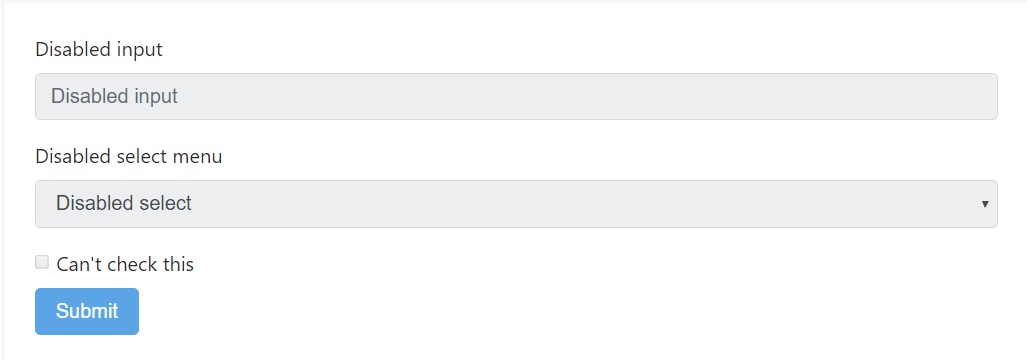
<form>
<fieldset disabled>
<div class="form-group">
<label for="disabledTextInput">Disabled input</label>
<input type="text" id="disabledTextInput" class="form-control" placeholder="Disabled input">
</div>
<div class="form-group">
<label for="disabledSelect">Disabled select menu</label>
<select id="disabledSelect" class="form-control">
<option>Disabled select</option>
</select>
</div>
<div class="checkbox">
<label>
<input type="checkbox"> Can't check this
</label>
</div>
<button type="submit" class="btn btn-primary">Submit</button>
</fieldset>
</form> Warning relating to web link functionality of <a>
By default, web browsers will certainly manage all of the native form controls (<input>, <select> plus <button> elements) inside a <fieldset disabled> as disabled, evading all key-board plus mouse interactions on all of them. Nevertheless, if your form also includes <a ... class="btn btn-*"> components, these will just be delivered a style of pointer-events: none. As noted in the section on disabled state for buttons (and especially in the sub-section for anchor elements ), this CSS feature is not really yet standardized and also isn't actually fully supported in Opera 18 and below, or in Internet Explorer 11, and won't avoid key board users from having the ability to concentrate or else turn on these particular urls. And so to be protected, utilize custom JavaScript to disable this kind of links.
Cross-browser congruity
Although Bootstrap is going to apply such styles inside all browsers, Internet Explorer 11 and below do not fully sustain the disabled attribute on a <fieldset>. Work with custom JavaScript to disable the fieldset in these kinds of browsers.
Readonly inputs
Provide the readonly boolean attribute on an input to prevent customization of the input's value. Read-only inputs appear lighter ( much like disabled inputs), however keep the basic pointer.

<input class="form-control" type="text" placeholder="Readonly input here…" readonly>Command sizing
Establish heights utilizing classes like .form-control-lg, plus set up widths using grid column classes like .col-lg-*.

<input class="form-control form-control-lg" type="text" placeholder=".form-control-lg">
<input class="form-control" type="text" placeholder="Default input">
<input class="form-control form-control-sm" type="text" placeholder=".form-control-sm">
<select class="form-control form-control-lg">
<option>Large select</option>
</select>
<select class="form-control">
<option>Default select</option>
</select>
<select class="form-control form-control-sm">
<option>Small select</option>
</select>Column sizes
Wrap inputs within a grid columns, or any sort of custom made parent component, in order to simply implement the desired widths.

<div class="row">
<div class="col-2">
<input type="text" class="form-control" placeholder=".col-2">
</div>
<div class="col-3">
<input type="text" class="form-control" placeholder=".col-3">
</div>
<div class="col-4">
<input type="text" class="form-control" placeholder=".col-4">
</div>
</div>Assistance text
The .help-block class is cancelled in the brand-new version. In the case that you need to put special added text message in order to help your website visitors to much better navigate - use the .form-text class alternatively. Bootstrap 4 possesses certain built in validation styles for the form controls being applied . In this version the .has-feedback class has been simply given up-- it is really no longer wanted along with the introduction of the .form-control-danger, .form-control-warning and .form-control-success classes adding a small-sized info icon directly inside the input fields.
Affiliating assistance content with form controls
Help message should be clearly connected with the form control it really connects to applying the aria-describedby attribute. This are going to ensure that the assistive technologies-- just like screen readers-- will declare this assistance text message when the user focuses or goes into the control.
Block level
Block assistance message-- for below inputs or for a lot longer lines of the support message-- can possibly be simply reached with .form-text. This particular class consists of display: block and adds in some top margin for easy spacing from the inputs above.

<label for="inputPassword5">Password</label>
<input type="password" id="inputPassword5" class="form-control" aria-describedby="passwordHelpBlock">
<p id="passwordHelpBlock" class="form-text text-muted">
Your password must be 8-20 characters long, contain letters and numbers, and must not contain spaces, special characters, or emoji.
</p>Inline
Inline text have the ability to work with any usual inline HTML feature (be it a , <span>, or else something else).

<form class="form-inline">
<div class="form-group">
<label for="inputPassword4">Password</label>
<input type="password" id="inputPassword4" class="form-control mx-sm-3" aria-describedby="passwordHelpInline">
<small id="passwordHelpInline" class="text-muted">
Must be 8-20 characters long.
</small>
</div>
</form>Validation
Bootstrap provides validation formats for success, danger, and warning states on the majority of form controls.
The best ways to operate
Here's a run-through of specifically how they work:
- To use, incorporate .has-warning, .has-danger, or .has-success to the parent feature. Any sort of .col-form-label, .form-control, or custom-made form element will acquire the validation formats.
- Contextual validation text, alongside your usual form field help text, may possibly be added with the utilization of .form-control-feedback. This specific text message is going to adapt to the parent .has-* class. By default it really simply involves a bit of margin for spacing and a changed color for each and every state.
- Validation icons are url()-s built by means of Sass variables which are applied to background-image statements for each and every state.
- You may operate your personal base64 PNGs or SVGs via updating the Sass variables plus recompiling.
- Icons have the ability to likewise be disabled entirely by establishing the variables to none or commenting out the source Sass.
Defining forms
Generally speaking, you'll desire to work with a certain state for specific kinds of responses:
- Danger is outstanding for when there's a blocking or else required field. A user must notify this particular field the right way to submit the form.
- Warning does the job well for input values that are in development, such as password strength, or soft validation just before a user tries to submit a form.
- And lastly, success is great for cases as you have per-field validation through a form and also would like to motivate a user throughout the rest of the fields.
Some examples
Here are some cases of the previously mentioned classes at work. First off is your regular left-aligned fields with labels, guide content, and validation message.
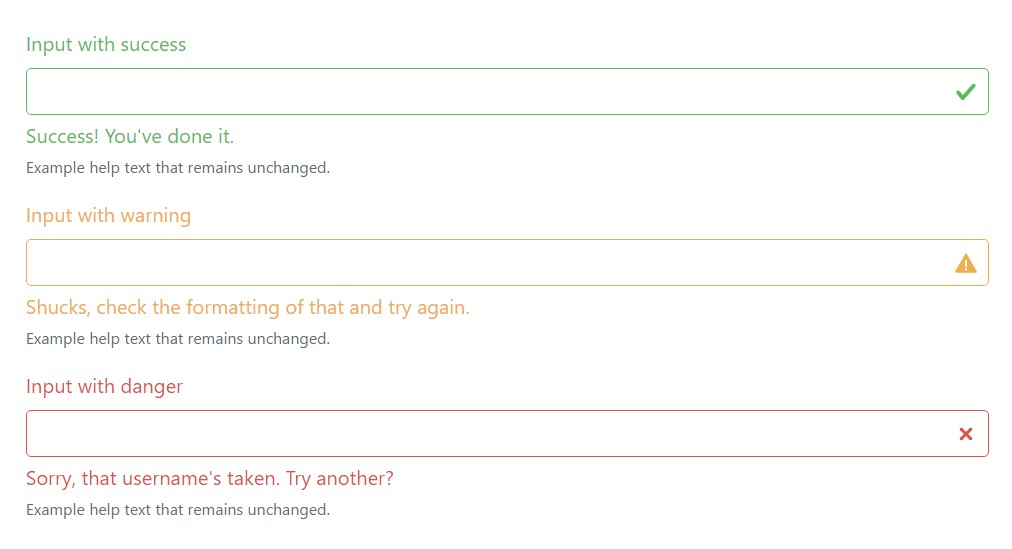
<div class="form-group has-success">
<label class="form-control-label" for="inputSuccess1">Input with success</label>
<input type="text" class="form-control form-control-success" id="inputSuccess1">
<div class="form-control-feedback">Success! You've done it.</div>
<small class="form-text text-muted">Example help text that remains unchanged.</small>
</div>
<div class="form-group has-warning">
<label class="form-control-label" for="inputWarning1">Input with warning</label>
<input type="text" class="form-control form-control-warning" id="inputWarning1">
<div class="form-control-feedback">Shucks, check the formatting of that and try again.</div>
<small class="form-text text-muted">Example help text that remains unchanged.</small>
</div>
<div class="form-group has-danger">
<label class="form-control-label" for="inputDanger1">Input with danger</label>
<input type="text" class="form-control form-control-danger" id="inputDanger1">
<div class="form-control-feedback">Sorry, that username's taken. Try another?</div>
<small class="form-text text-muted">Example help text that remains unchanged.</small>
</div>All those same states can additionally be employed along with horizontal forms.
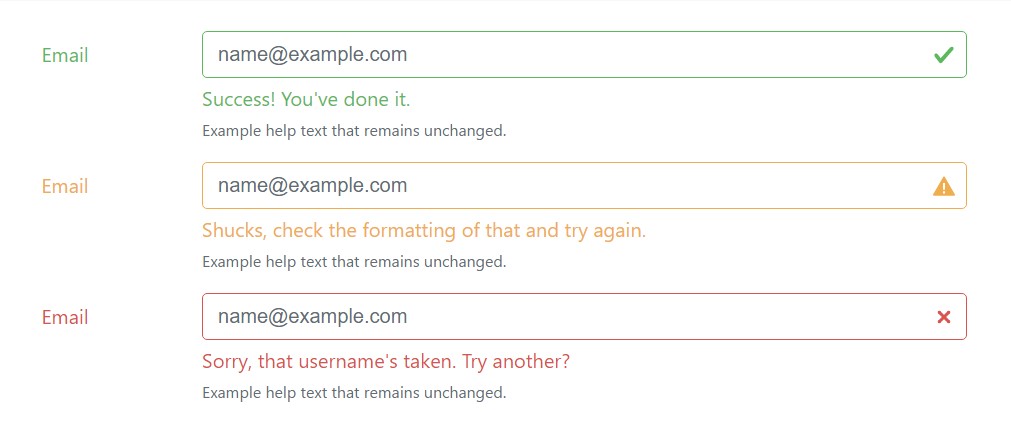
<div class="container">
<form>
<div class="form-group row has-success">
<label for="inputHorizontalSuccess" class="col-sm-2 col-form-label">Email</label>
<div class="col-sm-10">
<input type="email" class="form-control form-control-success" id="inputHorizontalSuccess" placeholder="[email protected]">
<div class="form-control-feedback">Success! You've done it.</div>
<small class="form-text text-muted">Example help text that remains unchanged.</small>
</div>
</div>
<div class="form-group row has-warning">
<label for="inputHorizontalWarning" class="col-sm-2 col-form-label">Email</label>
<div class="col-sm-10">
<input type="email" class="form-control form-control-warning" id="inputHorizontalWarning" placeholder="[email protected]">
<div class="form-control-feedback">Shucks, check the formatting of that and try again.</div>
<small class="form-text text-muted">Example help text that remains unchanged.</small>
</div>
</div>
<div class="form-group row has-danger">
<label for="inputHorizontalDnger" class="col-sm-2 col-form-label">Email</label>
<div class="col-sm-10">
<input type="email" class="form-control form-control-danger" id="inputHorizontalDnger" placeholder="[email protected]">
<div class="form-control-feedback">Sorry, that username's taken. Try another?</div>
<small class="form-text text-muted">Example help text that remains unchanged.</small>
</div>
</div>
</form>
</div>Radios and checkboxes are likewise supported.

<div class="form-check has-success">
<label class="form-check-label">
<input type="checkbox" class="form-check-input" id="checkboxSuccess" value="option1">
Checkbox with success
</label>
</div>
<div class="form-check has-warning">
<label class="form-check-label">
<input type="checkbox" class="form-check-input" id="checkboxWarning" value="option1">
Checkbox with warning
</label>
</div>
<div class="form-check has-danger">
<label class="form-check-label">
<input type="checkbox" class="form-check-input" id="checkboxDanger" value="option1">
Checkbox with danger
</label>
</div>Customized forms
For more modification plus cross browser stability, make use of Bootstrap totally custom-made form elements to change the internet browser defaults. They're built on very top of accessible and semantic markup, in this way they are really solid substitutes for any kind of default form control.
Disabled
Custom radios and checkboxes have the ability to likewise be disabled . Put in the disabled boolean attribute to the <input> plus the custom made indicator and label specification will be automatically styled.

<label class="custom-control custom-checkbox">
<input type="checkbox" class="custom-control-input" disabled>
<span class="custom-control-indicator"></span>
<span class="custom-control-description">Check this custom checkbox</span>
</label>
<label class="custom-control custom-radio">
<input id="radio3" name="radioDisabled" type="radio" class="custom-control-input" disabled>
<span class="custom-control-indicator"></span>
<span class="custom-control-description">Toggle this custom radio</span>
</label>Validation conditions
Add the other states to your custom-made forms along with Bootstrap validation classes.

<div class="form-group has-success">
<label class="custom-control custom-checkbox">
<input type="checkbox" class="custom-control-input">
<span class="custom-control-indicator"></span>
<span class="custom-control-description">Check this custom checkbox</span>
</label>
</div>
<div class="form-group has-warning">
<label class="custom-control custom-checkbox">
<input type="checkbox" class="custom-control-input">
<span class="custom-control-indicator"></span>
<span class="custom-control-description">Check this custom checkbox</span>
</label>
</div>
<div class="form-group has-danger mb-0">
<label class="custom-control custom-checkbox">
<input type="checkbox" class="custom-control-input">
<span class="custom-control-indicator"></span>
<span class="custom-control-description">Check this custom checkbox</span>
</label>
</div>Stacked
Custom made checkboxes and radios are inline to start. Add in a parent with class .custom-controls-stacked to make sure that each and every form control is on different lines.

<div class="custom-controls-stacked">
<label class="custom-control custom-radio">
<input id="radioStacked1" name="radio-stacked" type="radio" class="custom-control-input">
<span class="custom-control-indicator"></span>
<span class="custom-control-description">Toggle this custom radio</span>
</label>
<label class="custom-control custom-radio">
<input id="radioStacked2" name="radio-stacked" type="radio" class="custom-control-input">
<span class="custom-control-indicator"></span>
<span class="custom-control-description">Or toggle this other custom radio</span>
</label>
</div>Select menu
Custom made <select> menus really need only a custom class, .custom-select to activate the custom-made styles.

<select class="custom-select">
<option selected>Open this select menu</option>
<option value="1">One</option>
<option value="2">Two</option>
<option value="3">Three</option>
</select>File browser
The file input is the highly finest of the bunch and need added JavaScript in case you 'd like to catch them up through effective Choose file ... and selected file name message.
<label class="custom-file">
<input type="file" id="file" class="custom-file-input">
<span class="custom-file-control"></span>
</label>Here’s ways to utilize:
- We wrap the <input> inside a <label> so the customized control appropriately sets off the file browser.
- We conceal the default file <input> using opacity.
- We apply : after to produce a custom made background and directive (Choose file ...).
- We make use of :before to create and place the Web browser tab.
- We declare a height on the <input> for suitable spacing for surrounding material .
Simply puts, it's an absolutely custom component, all obtained with CSS.
Converting or altering the strings
The : lang() pseudo-class is utilized to enable straightforward interpretation of the "Browse" plus "Choose file ..." text into different languages. Just simply override or else incorporate entrances to the $ custom-file-text SCSS variable along with the associated language tab along with localized strings. The English strings may be customised similarly. For instance, here's exactly how one might actually provide a Spanish interpretation (Spanish's language code is es)
$custom-file-text: (
placeholder: (
en: "Choose file...",
es: "Seleccionar archivo..."
),
button-label: (
en: "Browse",
es: "Navegar"
)
);You'll ought to set up the language of your file ( or else subtree thereof) appropriately needed for the appropriate text message to become displayed. This may be completed working with the lang attribute as well as the Content-Language HTTP header, with some other solutions.
Conclusions
Generally all of these are the brand-new elements to the form elements added within current fourth version of the Bootstrap system. The total impression is the classes got more explicit and natural as a result-- much more convenient to utilize and having the custom control features we can now obtain much more predictable visual aspect of the features we include in the website page we create. Right now everything that is actually left for us is determine the appropriate info we would definitely require from our potential site visitors to fill in.
Tips on how to apply the Bootstrap forms:
Related topics:
Bootstrap forms formal documentation
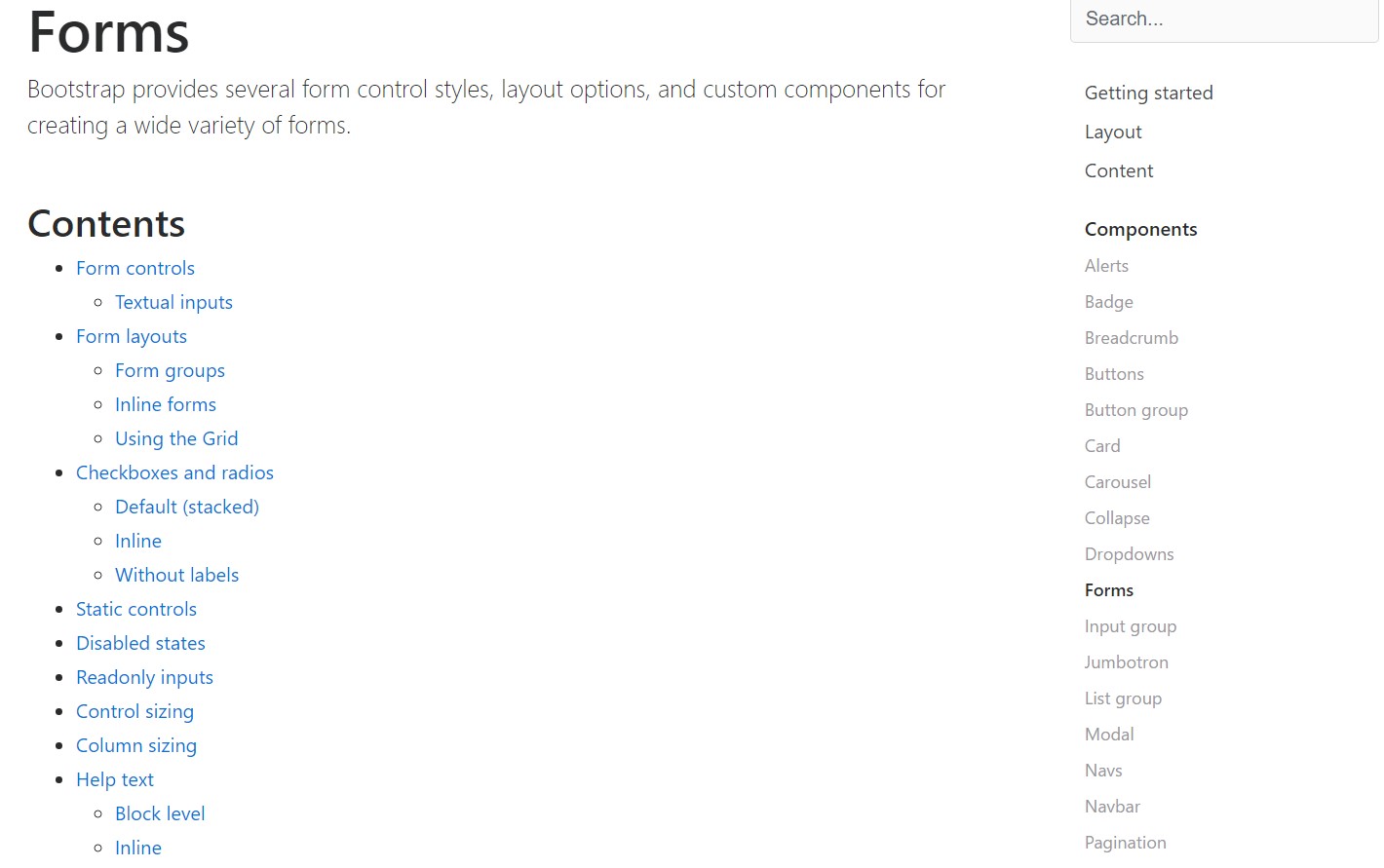
Bootstrap information
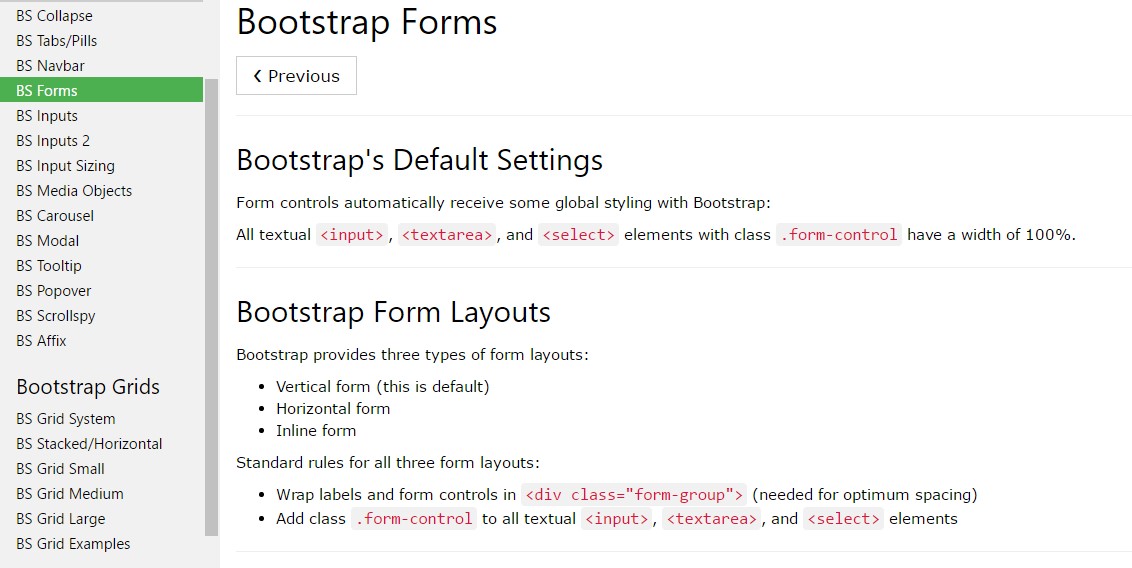
Support for Bootstrap Forms
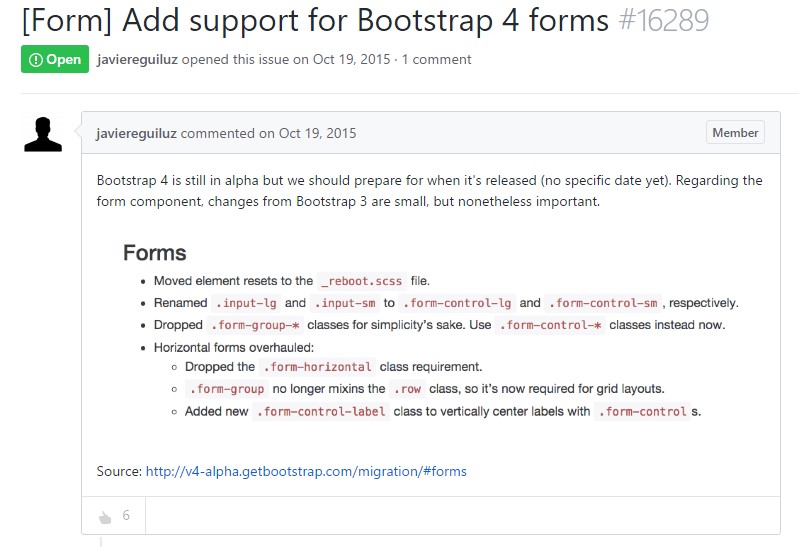
Let us review AMP project and AMP-form component?
